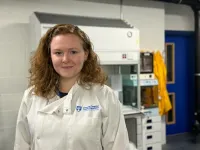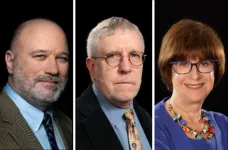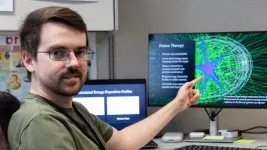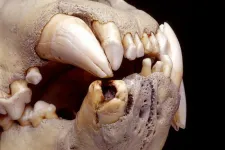(Press-News.org) SAN ANTONIO, Oct. 11, 2024 – David Gius, MD, PhD, professor in the Department of Radiation Oncology and assistant dean of research at The University of Texas Health Science Center at San Antonio (UT Health San Antonio), was named this year’s recipient of the prestigious American Society for Radiation Oncology (ASTRO) Career Recognition Mentorship Award.
Gius is associate cancer center director for translational research at Mays Cancer Center at UT Health San Antonio. He is among three awardees receiving this recognition. The award honors individuals who have made significant contributions to mentorship and education in radiation oncology. It highlights the importance of guidance and development of future professionals in the field of radiation oncology.
“I am truly honored to receive the ASTRO Mentorship Award,” said Gius. “Mentorship is vital in our field and an important part of our profession. I have been privileged to work alongside so many talented young radiation oncologists.”
Gius began mentoring in 1997. Since then, he has trained 65 undergraduate and graduate students, post-doctoral and clinical fellows, radiation oncologists and junior faculty. Twenty-five of his trainees are currently faculty members at medical schools across the country. Thirteen are full professors and 12 are funded cancer researchers. Gius credits his mentorship success to his own mentors, who taught him to prioritize programs that encourage sharing best practices, valuable guidance, support and expertise to young radiation oncologists who are navigating a rapidly evolving field.
“This honor recognizes Dr. Gius’ dedication to education, mentorship and professional growth of future leaders,” said Mark Bonnen, MD, chair of radiation oncology at UT Health San Antonio and chief medical officer of the Mays Cancer Center. “Dr. Gius’ work is instrumental in creating collaboration and fostering a supportive environment for young professionals.”
Gius specializes in breast and thoracic radiation oncology and investigates the cellular processes related to aging, metabolism and cancer. He is the only radiation oncologist to serve as an Established Investigator Scholar in Cancer Research as part of the Cancer Prevention Research Institute of Texas, also known as CPRIT. Gius’ contributions to the mentorship program at Mays Cancer Center elevates the learning experience for many aspiring radiation oncologists.
“Developing mentorship programs for trainees and faculty members at all levels is a priority of our cancer center,” said Lei Zheng, MD, PhD, executive director of Mays Cancer Center at UT Health San Antonio. “Dr. Gius set up a role model for all of us at the Mays Cancer Center.”
The Mays Cancer Center at UT Health San Antonio is one of only four National Cancer Institute-designated Cancer Centers in Texas. The Mays Cancer Center provides leading-edge cancer care, propels innovative cancer research and educates the next generation of leaders to end cancer in South Texas. To learn more, visit https://cancer.uthscsa.edu/.
Stay connected with the Mays Cancer Center on Facebook, Twitter, LinkedIn, Instagram and YouTube.
The University of Texas Health Science Center at San Antonio (UT Health San Antonio) is one of the country’s leading health science universities and is designated as a Hispanic-Serving Institution by the U.S. Department of Education. With missions of teaching, research, patient care and community engagement, its schools of medicine, nursing, dentistry, health professions, graduate biomedical sciences and public health have graduated more than 43,886 alumni who are leading change, advancing their fields and renewing hope for patients and their families throughout South Texas and the world. To learn about the many ways “We make lives better®,” visit UTHealthSA.org.
Stay connected with The University of Texas Health Science Center at San Antonio on Facebook, Twitter, LinkedIn, Instagram and YouTube.
END
Mays Cancer Center radiation oncologist recognized as outstanding mentor to next generation leaders
2024-10-11
ELSE PRESS RELEASES FROM THIS DATE:
Hitting the bull’s eye to target ‘undruggable’ diseases – researchers reveal new levels of detail in targeted protein degradation
2024-10-11
Hitting the bull’s eye to target ‘undruggable’ diseases – researchers reveal new levels of detail in targeted protein degradation
Targeted protein degradation has opened up a new field of drug discovery with potential to treat previously ‘undruggable’ diseases
Dundee researchers have revealed new levels of details of how protein degraders work
The work means new drugs can be much more accurately targeted at the molecular level, creating and hitting a metaphorical ...
SCAI publishes expert consensus statement on managing patients with ST-elevated myocardial infarction
2024-10-11
WASHINGTON —The Society for Cardiovascular Angiography & Interventions (SCAI) is pleased to announce the publication of the Expert Consensus Statement on the Management of Patients with STEMI Referred for Primary PCI.
Published in JSCAI, the consensus statement provides detailed suggestions for clinicians, particularly for nuanced situations not covered by general guidelines. It highlights the strengths and limitations of various diagnostic and therapeutic interventions for treating patients with STEMI, provides ...
Engineering perovskite materials at the atomic level paves way for new lasers, LEDs
2024-10-11
Researchers have developed and demonstrated a technique that allows them to engineer a class of materials called layered hybrid perovskites (LHPs) down to the atomic level, which dictates precisely how the materials convert electrical charge into light. The technique opens the door to engineering materials tailored for use in next-generation printed LEDs and lasers – and holds promise for engineering other materials for use in photovoltaic devices.
Perovskites, which are defined by their crystalline ...
Kessler Foundation 2024 Survey highlights key strategies for hiring and supporting workers with disabilities in the hospitality industry
2024-10-11
East Hanover, NJ – October 11, 2024 – A new Kessler Foundation survey of supervisors in the hospitality industry – focused on restaurant and traveler accommodations – has revealed critical insights into the recruitment, support, and accommodation of workers with disabilities. The findings, released today in a special live Zoom webinar, offer actionable takeaways for employers looking to diversify their workforce and enhance workplace inclusion. Key points revealed that proactive recruitment, effective partnerships, and ...
Harnessing protons to treat cancer
2024-10-11
NEWPORT NEWS, VA – Radiation therapy techniques have been used for more than a century to treat cancers. Physicists in the Radiation Detector and Imaging group and associated with the Biomedical Research & Innovation Center (BRIC) at the U.S. Department of Energy’s Thomas Jefferson National Accelerator Facility have been for several years pursuing radiation therapy technology improvements in collaboration with the Hampton University Proton Cancer Institute (HUPCI). Now, BRIC physicists are launching a study into how best to advance different types of radiation therapy.
BRIC scientists plan to evaluate the ability of accelerator-based ...
Researchers identify neurodevelopmental symptoms that indicate genetic disorders
2024-10-11
In a new study, UCLA Health researchers have found that motor delay and low muscle tone were common signs of an underlying genetic diagnosis in children with neurodevelopment disorders.
Given the limited existing data on the early neurodevelopmental symptoms that predict a positive genetic diagnosis, the study authors aimed to research which factors in this subset of children indicated the need of a genetic test. “With genetic testing, a diagnostic result can have benefits on medical care, but ...
Electronic nudges to increase influenza vaccination in patients with chronic diseases
2024-10-11
About The Study: In a nationwide randomized clinical implementation trial, electronically delivered letter-based nudges markedly increased influenza vaccination compared with usual care among young and middle-aged patients with chronic diseases. The results of this study suggest that simple, scalable, and cost-efficient electronic letter strategies may have substantial public health implications.
Corresponding Author: To contact the corresponding author, Tor Biering-Sorensen, MD, MSc, MPH, PhD, email tor.biering@gmail.com.
To access the embargoed ...
Plant stem cells: Better understanding the biological mechanism of growth control
2024-10-11
Plants form new leaves, flowers and roots at the tips of shoots and roots, in specific growth regions known as meristems. These meristems contain stem cells that divide as needed and form new cells that develop into specialised tissue. Using the example of plant roots, researchers from Freiburg have now been able to decipher which regulatory mechanisms ensure that growth in the meristem occurs in a controlled manner. The results have been published in the journal Nature Plants.
Stem cells are dependent on ...
Genomic study identifies human, animal hair in ‘man-eater’ lions’ teeth
2024-10-11
CHAMPAIGN, Ill. — In 1898, two male lions terrorized an encampment of bridge builders on the Tsavo River in Kenya. The lions, which were massive and maneless, crept into the camp at night, raided the tents and dragged off their victims. The infamous Tsavo “man-eaters” killed at least 28 people before Lt. Col. John Henry Patterson, the civil engineer on the project, shot them dead. Patterson sold the lions’ remains to the Field Museum of Natural History in Chicago in 1925.
In a new study, Field Museum researchers collaborated with scientists at the University of Illinois Urbana-Champaign on an in-depth analysis of hairs carefully extracted ...
These 19th century lions from Kenya ate humans, DNA collected from hairs in their teeth shows
2024-10-11
By isolating and sequencing DNA in compacted hairs collected from the teeth of two Tsavo lion museum specimens from the 1890s, researchers have found that the historic lions from Kenya preyed on a variety of species, including humans, giraffes, and wildebeests. These so-called “Tsavo Man-Eaters” are estimated to have killed at least dozens of people, including those working along the Kenya-Uganda Railway in the late 1890’s. The findings appear in the Cell Press journal Current Biology on October 11.
“As ...




